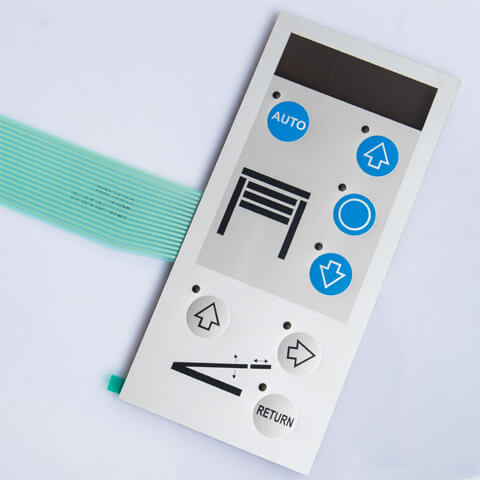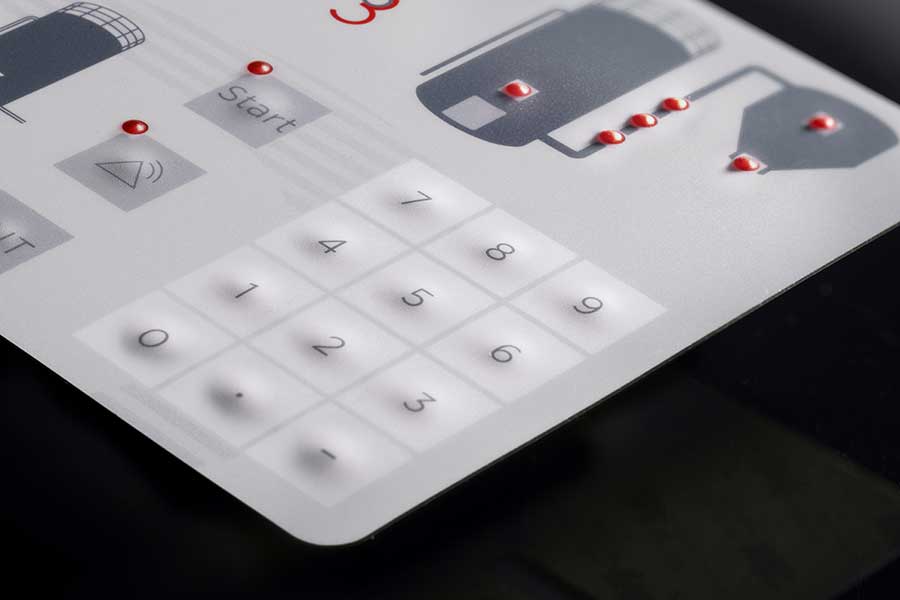How Membrane Switches Are Used to Boost Safety and Functionality in Manufacturing Systems
How Membrane Switches Are Used to Boost Safety and Functionality in Manufacturing Systems
Blog Article
Membrane Change Modern Technology: The Key to Trustworthy and Cost-Effective Interfaces
Membrane layer button innovation has actually emerged as an essential element in the style of user interfaces, offering both reliability and cost-effectiveness throughout a varied range of applications. As we explore the diverse advantages of membrane switches, their possibility for innovation elevates questions regarding future applications and developing trends.
Understanding Membrane Change Innovation
Membrane switch modern technology is an extensively made use of interface service in different electronic tools, supplying a smooth blend of capability and layout. This innovation integrates multiple layers of products, normally consisting of a graphic overlay, spacer layer, and a circuit layer. The visuals overlay shows the interface aspects, while the spacer layer divides the circuit layer from the overlay until an individual turns on a switch.
When stress is put on the overlay, the circuit layer finishes the electrical circuit, sending out a signal to the tool. This mechanism permits different arrangements, including responsive responses and backlighting choices, enhancing customer interaction. Membrane layer buttons are typically made utilizing durable products such as polyester or polycarbonate, guaranteeing long life and resistance to environmental aspects like moisture and dirt.
The adaptability of membrane switches enables their application in varied industries, consisting of medical devices, customer electronics, and industrial controls. Their portable layout permits assimilation into space-constrained settings, offering a reliable individual interface without compromising visual allure. Comprehending the details of membrane button modern technology is vital for manufacturers and designers looking for to create reputable and reliable human-machine interfaces.
Secret Benefits of Membrane Switches
While different user interface solutions exist, membrane changes deal distinct advantages that make them a favored selection in countless applications. One of the main advantages is their durability; membrane switches are developed to hold up against harsh environmental conditions, including wetness, dirt, and temperature level fluctuations, guaranteeing durable efficiency. This resilience substantially lowers the need for frequent replacements, thus reducing general upkeep expenses.

In addition, membrane layer buttons are lightweight and compact, making them suitable for applications where room is restricted. Their inconspicuous style contributes to a streamlined look without jeopardizing functionality.
Cost-effectiveness is also a remarkable benefit, as the manufacturing process for membrane layer changes tends to be more economical compared to conventional mechanical switches. This affordability, integrated with their dependability and simplicity of installation, placements membrane switches as a useful remedy for a large variety of industries looking for efficient and reliable individual interfaces.
Applications Across Different Industries
How do membrane layer switches adjust to the diverse demands of different sectors? Membrane layer switch innovation is increasingly identified for its flexibility, making it ideal for a large range of applications across numerous sectors. In the clinical field, membrane layer buttons are used in analysis equipment and person monitoring tools, where their resilience and ease of cleaning are crucial for preserving health requirements. The automobile industry employs these buttons in control panels and control panels, supplying a streamlined aesthetic while making my explanation certain easy to use procedure.
In consumer electronic devices, membrane layer switches offer a small remedy for push-button controls and home appliances, improving customer experience via intuitive design. In addition, the commercial sector leverages membrane layer switches for machinery control panels, gaining from their resistance to extreme settings, such as moisture and dust.
Armed forces and aerospace applications also make use of membrane layer buttons for their integrity and ability to endure extreme conditions, guaranteeing operational effectiveness in important scenarios. In addition, the food and drink sector takes on these buttons for automated systems, where cleanliness and simplicity of operation are critical. Inevitably, membrane layer buttons are customized to fulfill the special needs of each market, showing their vital function in modern technology user interfaces
Layout and Personalization Choices

In the realm of membrane layer switch technology, layout and modification choices play a pivotal duty in improving functionality and customer communication. These switches can be customized to satisfy specific functional Read Full Report requirements and visual preferences, making them versatile parts in different applications.
Among the main customization alternatives is the layout of the button itself, which can be developed to accommodate distinct user interfaces and ergonomic factors to consider. check here By readjusting the form, size, and arrangement of switches, suppliers can produce instinctive styles that promote ease of usage. Additionally, the unification of different shades and graphic overlays enables branding and improved presence, ensuring that customers can rapidly recognize functions.
In addition, membrane buttons can be crafted with different responsive comments devices, such as raised switches or distinct clicks, to enhance the individual experience. Different materials can likewise be selected for toughness and ecological resistance, dealing with variables such as moisture, temperature variations, and chemical exposure.
Eventually, the substantial layout and modification options available in membrane button modern technology empower businesses to create customized solutions that not only satisfy useful needs but also line up with their branding and operational needs.

Future Trends in Membrane Layer Buttons
As membrane layer switch technology proceeds to advance, future trends are progressively concentrated on boosting customer experience and integrating advanced performances. One considerable fad is the assimilation of touch-sensitive and capacitive technologies into conventional membrane switches. This advancement permits for more user-friendly interface, supplying responsive responses while keeping a streamlined layout.
Another arising fad is using eco-friendly materials, driven by the growing demand for sustainable manufacturing practices. Suppliers are seeking to reduce their carbon footprint by utilizing recyclable substratums and low-impact inks, straightening with international sustainability objectives.
In addition, the rise of the Web of Things (IoT) is triggering the incorporation of clever functions right into membrane layer switches. Enhanced connectivity options will make it possible for tools to connect with each various other, enabling smooth combination into wider systems.
Additionally, advancements in printing modern technologies, such as digital printing, are enabling greater design flexibility and modification. This makes it possible for makers to produce elaborate designs and vibrant shades cost-effectively.

Conclusion
In verdict, membrane layer switch modern technology represents a crucial development in customer interface layout, using significant benefits in sturdiness, customization, and cost-effectiveness. As improvements proceed to emerge, specifically in touch-sensitive interfaces and lasting products, the potential for membrane layer switches to improve customer experience and functionality stays encouraging.
Report this page